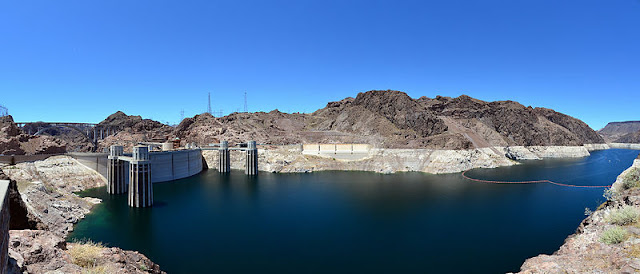Hoover Dam – Remarkable Structure in Modern History
Hoover Dam, one of the most remarkable structures in modern history, once known as Boulder Dam is a concrete arch-gravity dam in the Black Canyon of Colorado River. This is on the border between the U.S. states of Arizona and Nevada and was built between 1931 and 1936 at the time of the Great Depression.
In early 20th century, the U.S. Bureau of Reclamation formulated plans for a huge dam on the Arizona-Nevada border to control the Colorado River and to provide water as well as hydroelectric power to the developing Southwest area.
Construction of the same was an immense challenge with the crew getting bored with carbon monoxide choked tunnels and dangling from heights of 800 feet in order to clear canyon walls.
The largest dam in the world during its time of completion in 1935, this National Historic Landmark tends to store up to 9.2 trillion gallons of water which is equal to two years of the river’s annual flow, in Lake Mead in order to irrigate 2 million acres of land as well as serves as the most famous tourist attraction. The view from the dam provides a spectacular look at Lake Mead, the country’s largest man made reservoir.
Dedicated By President Franklin D. Roosevelt
It had been dedicated by President Franklin D. Roosevelt on September 39, 1935. The construction of the dam was the consequence of a huge effort involving thousands of worker which cost over one hundred lives and the dam was eventually named after President Herbert Hoover.
This Hoover dam of 1244 feet length, 660 feet thick and 726 feet high concrete behemoth tends to hold back so much water that it deformed the earth’s crust causing 600 small earthquakes in the decade after it was constructed.
More than 100 workers had died constructing the Hoover Dam and according to legends, some of them seemed to be buried within its concrete cover-up. Out of those, 96 have been identified as official `industrial victims’, enabling the families of the victim to obtain compensation for the same. Those that were not included in the 96 were the individuals who had died from pneumonia, a diagnosis which is believed to be a cover for exposure to high levels of carbon monoxide.
Six Companies – Body Governing Huge Construction
Those who had perished due to pneumonia often seemed to work with gasoline powered equipment in a 140 degree F, in poorly ventilated space. On claiming pneumonia as the cause of death enabled Six Companies, the body governing this huge construction undertaking to follow a loophole preventing the payment of death benefits to families and surprisingly no one had died of pneumonia during that period.
Massive seven foot deep and seven foot wide buckets were used to pour concrete into square and rectangular forms ranging from 25 by 25 feet to 25 by 60 feet, to build the dam.
Based on the square footage of the block required, the concrete level would rise to around two to six inches after each pouring of the concrete which made it quite difficult to lose a worker in a small increase in depth.
Falling into the concrete could have become a problem but the workers were quickly extracted before the concrete would get hardened up.








No comments:
Post a Comment
Note: Only a member of this blog may post a comment.